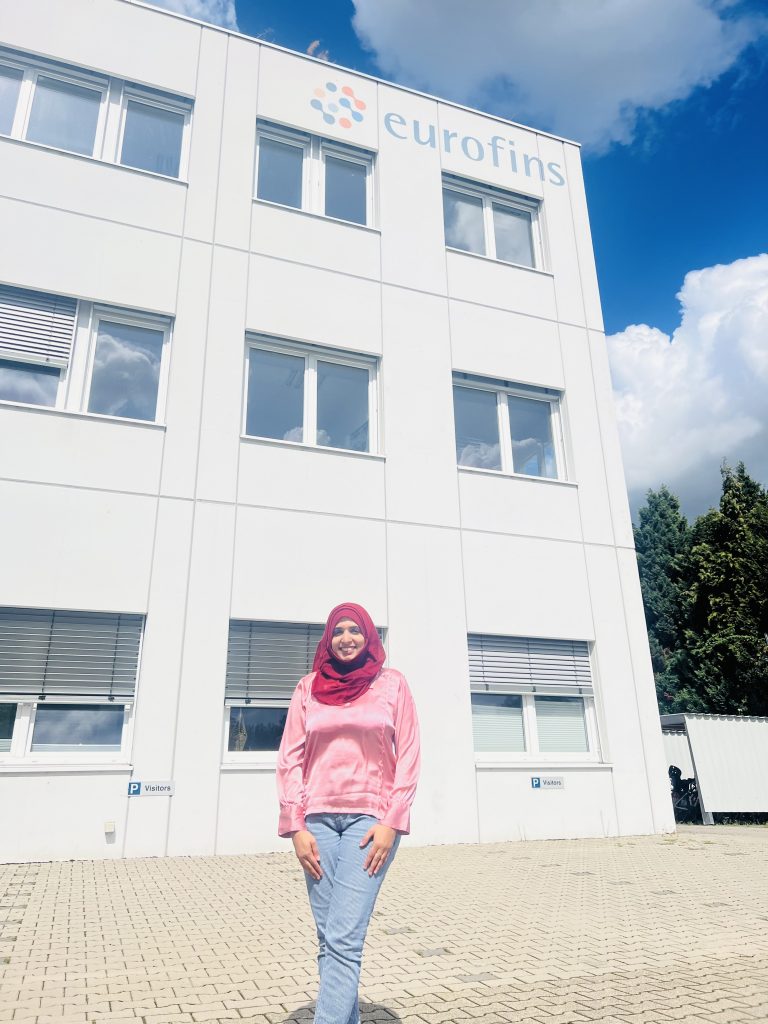In this blogpost, Sadia Rahat shares her internship experience at Eurofins. Students of the Environmental Pollution Management (Ecotoxicology) Program complete an 8-week internship each year, the so-called “AMEO”. The AMEO is performed either at an external university, governmental or industrial research institute where students learn to apply the competences achieved during their study. Students also use this opportunity to travel and explore Germany.
“My name is Sadia Rahat. I completed my internship at Eurofins Aquatic Research Laboratories. Eurofins Aquatic Research Laboratories stands as a beacon of excellence in the realm of environmental research and aquatic toxicology. They offer a comprehensive suite of aquatic toxicity tests, which are pivotal in assessing the health of aquatic ecosystems. From fish acute toxicity tests to early life-stage toxicity tests, from Daphnia magna studies to Chironomusriparius sediment/water toxicity testing, Eurofins covers a wide spectrum of aquatic life assessments. These tests provide critical insights into the effects of contaminants and stressors on aquatic organisms, contributing to a deeper understanding of the health and resilience of aquatic ecosystems.
Eurofins Aquatic Research Laboratories is located at about 70-kilometers away from Landau, and my daily commute involved traveling by buses and trains, which provided an opportunity to appreciate the scenic beauty of the region. The laboratory’s staff was not only friendly but also exceptionally intellectual and cooperative, creating a welcoming and collaborative atmosphere. The international ambience of the workplace added to its charm, making it feel like a second home to me during my time there. This harmonious blend of a convenient location, amiable colleagues, and an international environment made my experience at Eurofins both professionally enriching and personally fulfilling. I wholeheartedly recommend Eurofins to all fellow-students, as it not only provides a holistic learning experience but also creates a comfortable and welcoming environment that you wish to stay in longer. I am deeply grateful to Ms. Katrin Weber and Mr. Thomas Moser for granting me this valuable opportunity to work at Eurofins, and I extend my heartfelt thanks to all the team members who generously answered my numerous questions throughout my internship journey.
Eurofins, renowned for its commitment to scientific excellence, was the perfect environment to expand my horizons in field of aquatic toxicity testing. The firm consistently upholds the highest standards of research integrity and quality by adhering to the principles of Good Laboratory Practices(GLP) , ensuring the reliability and credibility of our scientific endeavors. One of the cornerstones of my experience at Eurofins was my involvement in fish acute toxicity tests and early life stage toxicity tests that allowed me to delve into the vulnerabilities of aquatic organisms and their response to chemical stressors. I first learned how to culture fish and fish food such as preparation of artemian solutions for fish cultures and test items. I also learned fish liver dissection and homogenization. This meticulous process illuminated the inner workings of these organisms, offering a deeper understanding of how toxic substances could affect vital organs and contribute to the processes of biomagnification or bioaccumulation. It underscored the importance of scientific analysis and the role it plays in ecological research.
Daphnia magna became my close companions during my time at Eurofins. I engaged in acute toxicity tests as well as reproductive toxicity tests with this biomonitoring species. These tests were instrumental in assessing the reproductive health of aquatic ecosystems and understanding how contaminants could disrupt their delicate balance. Chironomusripariussediment/water toxicity testing opened up a new dimension in my research journey. Exploring the interactions between sediment and water, and how they influence the organisms dwelling within them, was a captivating endeavor. This particular test shed light on the intricate web of relationships within aquatic ecosystems.
Myriophyllums are the aquatic plants that play a crucial role in maintaining water quality and supporting aquatic life. I learned how to access the species interaction in water with respect to water sediment toxicity testing and to monitor its response to toxic substances. It was not only intellectually stimulating but also underscored the delicate balance that exists in aquatic ecosystems. Furthermore, I also gained proficiency in assessing the impact of stressors on Lemna, commonly known as duckweed, using OECD-established protocols for conducting Macrophytes-specific tests. I learned the techniques of Lemna species growth inhibition test, the water-sediment Myriophyllum spicatum toxicity test, and the sediment-free Myriophyllum spicatum toxicity test. These tests illuminated how resilient some aquatic species can be and offered hope for the potential recovery of ecosystems even after exposure to toxins.
However, Eurofins offered more than just a chance to conduct tests. It provided a holistic training ground for all aspects of ecological research. I had the privilege of learning the intricacies of algae breeding, which serves as a foundation for understanding primary producers in aquatic ecosystems. I honed my skills in preparing algae growing media, a critical task that ensures optimal experimental conditions and reliable results. Fish breeding, an essential part of maintaining test organisms, was also a part of my training. The preparation of Artemia culture, a fundamental element in aquatic research, became second nature. Additionally, I was also part of frog breeding and management that was also quite delicate and exciting.
In conclusion, my journey at Eurofins was an enriching and multifaceted experience that deepened my proficiency in toxicological assessments and refined my laboratory skills. It allowed me to explore the intricate world of aquatic toxicity tests, ecological research, and the essential role of various organisms in maintaining the delicate balance of aquatic ecosystems. The knowledge and skills gained during this period continue to shape my passion for environmental conservation and my commitment to understanding and preserving the wonders of aquatic life. “
Here are some beautiful glimpses from Sadia’s AMEO:-


